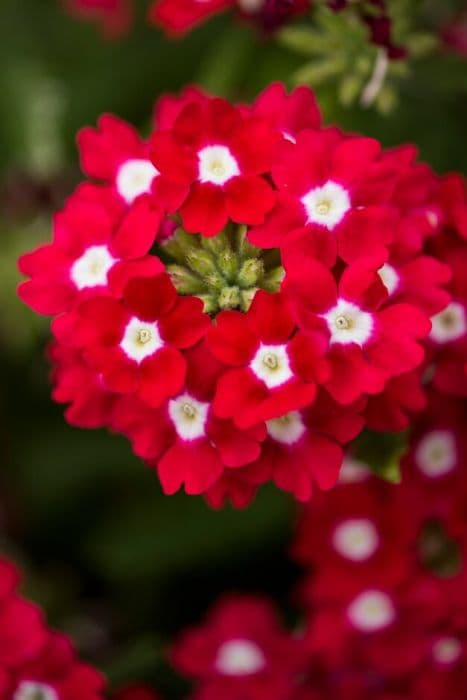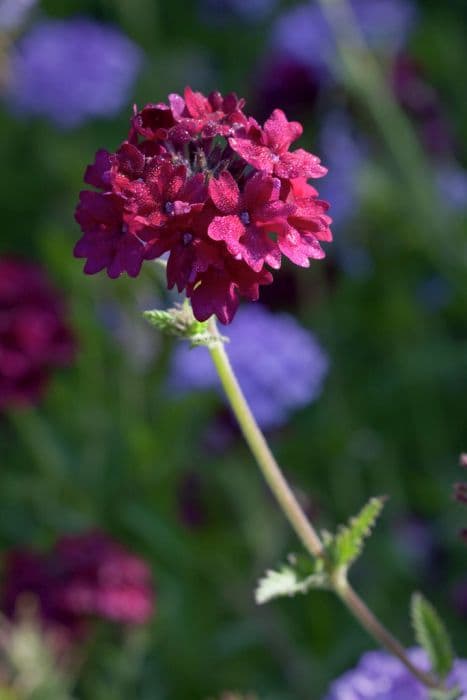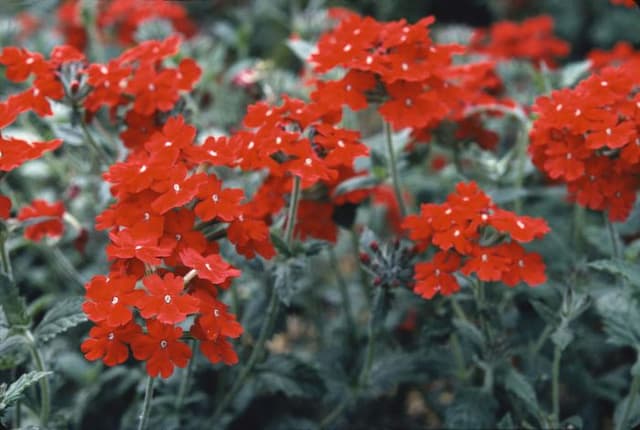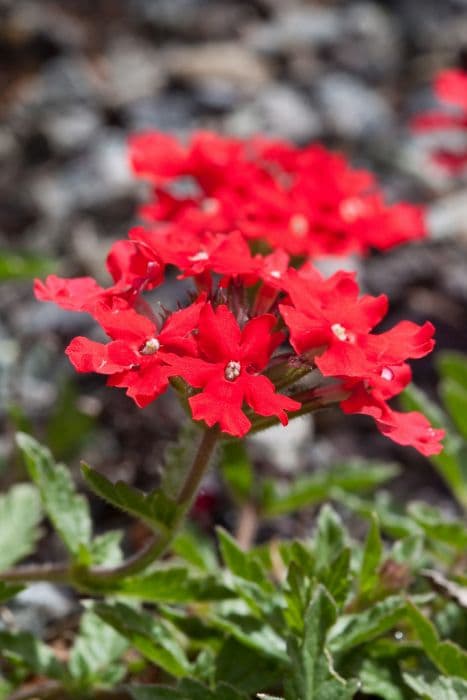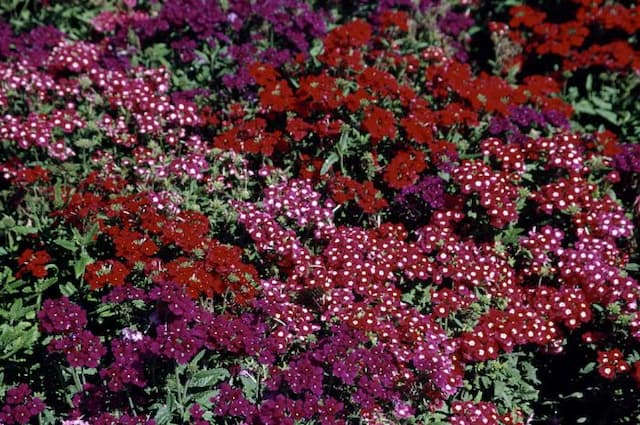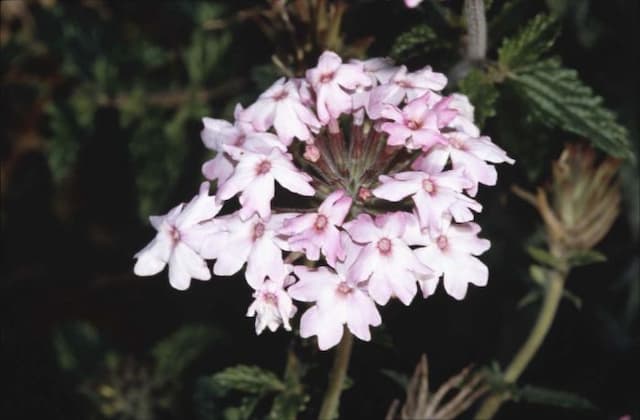Moss Verbena Glandularia Seabrook's Lavender = 'Sealav' (PBR)
![vervain [Seabrook's Lavender]](/_next/image?url=https%3A%2F%2Fplants-admin.emdemapps.com%2Fimages%2Fplants%2F%2Fimages%2F604b650ea9729.png&w=3840&q=75)
ABOUT
The Glandularia Seabrook's Lavender, commonly known as 'Sealav', is a flowering perennial with a striking appearance. The plant is characterized by its vibrant lavender-colored flowers, which are shaped like small trumpets and form clusters at the tips of the stems. These flowers are known for their enchanting fragrance, which is reminiscent of traditional lavender varieties and adds a sensory appeal to gardens and landscapes. The leaves of the 'Sealav' are equally attractive, boasting a deep green color and a slightly fuzzy texture. They are finely dissected, giving them a lacy look that complements the softness of the blossoms. The foliage often forms a dense and lush groundcover that provides a beautiful backdrop for the blossoms. This variety has a bushy, spreading habit, which enables it to fill garden spaces with ease, creating a sea of lavender when planted en masse. Its vivid colors are known to attract pollinators such as butterflies and bees, adding to the dynamic and lively ambiance of any garden setting in which it's placed. With a tendency to bloom profusely, the 'Sealav' provides extended periods of color, offering visual interest throughout its flowering season. While the precise dimensions of this plant are not to be included, its robust and ornamental nature makes it a popular choice for borders, containers, and as a focal point in garden designs where its showy appearance can be fully appreciated.
About this plant
 Names
NamesSynonyms
Seabrook's Lavender, Garden Verbena.
Common names
Glandularia Seabrook's Lavender 'Sealav' (PBR).
 Toxicity
ToxicityTo humans
Seabrook's Lavender is not widely recognized as a toxic plant to humans. There is limited information available about its toxicity, implying that it is generally considered safe. However, it is always prudent to avoid ingesting plants not intended for consumption, as individual reactions can vary and some could experience mild stomach upset or an allergic reaction.
To pets
Seabrook's Lavender is also not commonly known to be toxic to pets. There is minimal information indicating harmful effects if pets consume this plant. As with humans, ingestion of non-food plants should be avoided to prevent any potential gastrointestinal discomfort or allergic reactions in sensitive pets. Always monitor pets around plants and consult a veterinarian if any adverse symptoms appear after ingestion.
 Characteristics
CharacteristicsLife cycle
Perennials
Foliage type
Deciduous
Color of leaves
Green
Flower color
Purple
Height
1 foot 6 inches (45 cm)
Spread
2 feet (60 cm)
Plant type
Herb
Hardiness zones
9
Native area
Americas
Benefits
 General Benefits
General Benefits- Attracts pollinators: 'Sealav' is known to attract bees and butterflies, which are beneficial for pollination and maintaining a healthy ecosystem.
- Drought tolerance: Once established, it has good drought tolerance, reducing the need for frequent watering.
- Low maintenance: It generally requires minimal care, making it a good option for both novice and experienced gardeners.
- Aesthetic appeal: With its vibrant flowers and pleasant fragrance, it adds color and sensory interest to gardens and landscapes.
- Deer resistance: It is less palatable to deer, which can help prevent damage to the garden.
- Long flowering season: It blooms for an extended period, usually from early summer until the first frosts, providing long-lasting visual interest.
 Medical Properties
Medical PropertiesThis plant is not used for medical purposes.
 Air-purifying Qualities
Air-purifying QualitiesThis plant is not specifically known for air purifying qualities.
 Other Uses
Other Uses- Natural Dye: The blossoms of Glandularia Seabrook's Lavender can be used to create a natural dye for fabrics, yielding subtle purple hues characteristic of the lavender flowers.
- Crafts and Potpourri: Dried flowers of Seabrook's Lavender are often incorporated into potpourri mixes for their fragrance, or used in various craft projects, such as homemade sachets and scented bookmarks.
- Garden Border Accents: Due to its compact growth and vibrant flowers, Seabrook's Lavender can be used to create visually appealing borders in garden design.
- Floral Arrangements: Fresh or dried, the flowers of Glandularia Seabrook's Lavender can add color and fragrance to floral bouquets and centerpieces.
- Culinary Garnish: Although not commonly used for consumption, the flowers can sometimes be utilized as an edible garnish for desserts and drinks for a touch of elegance.
- Insect Repellent: The plant's natural aromatic oils can serve as a mild insect repellent when planted in an outdoor living area or near windows.
- Photography Prop: Its attractive blooms and foliage make Seabrook's Lavender a sought-after subject for photographers, particularly in macro and garden photography.
- Educational Tool: The plant can be used in school projects or botanical studies to teach about pollinators, as it is known to attract bees and butterflies.
- Soil Erosion Control: Seabrook's Lavender's rooting system can help stabilize soil in areas prone to erosion, thanks to its mat-forming growth habit.
- Companion Planting: Some gardeners plant Seabrook's Lavender near other plants to take advantage of its ability to attract beneficial insects that help pollinate vegetables and fruits.
Interesting Facts
 Feng Shui
Feng ShuiThe plant Moss Verbena is not used in Feng Shui practice.
 Zodiac Sign Compitability
Zodiac Sign CompitabilityThe plant Moss Verbena is not used in astrology practice.
 Plant Symbolism
Plant Symbolism- Calmness: Lavender, including Seabrook's Lavender, is often associated with calmness and tranquility, reflecting its soothing scent which has been used for relaxation and stress relief.
- Purity: The clean and fresh fragrance of lavender is symbolically linked to purity and cleanliness.
- Devotion: Lavender is also associated with devotion, representing a steadfast commitment, as the plant is known for its hardiness and ability to thrive in various conditions.
- Healing: Historically, lavender has been used for medicinal purposes, symbolizing healing and restoration of health.
- Beauty: The elegant and aesthetic presentation of the lavender's blooms is a symbol of beauty and grace.
- Silence: Due to its calming properties, lavender is sometimes symbolically associated with silence and peace.
 Water
WaterFor Seabrook's Lavender, watering should be done when the top inch of soil feels dry to the touch, which typically means watering once every week during active growth periods. Ensure the plant gets a thorough soak by adding water until it begins to drain out of the bottom of the container—this could mean using approximately 16 to 32 ounces for a standard pot size. Reduce watering frequency to every other week during the dormant season, ensuring the soil doesn't stay soggy. Adjust the frequency according to weather conditions, watering more often during hot, dry spells, and less during cooler, wet periods.
 Light
LightSeabrook's Lavender thrives in full sun conditions, requiring at least 6 to 8 hours of direct sunlight per day. It is best to place the plant in a location where it can receive unobstructed sunlight, such as a south-facing window indoors or a sunny spot in the garden. If grown outdoors, ensure it's positioned where daily sunlight is abundant to encourage robust growth and vibrant flowering.
 Temperature
TemperatureSeabrook's Lavender prefers warm conditions and can tolerate a temperature range from around 60°F to 85°F. It is not frost-hardy, so the minimum temperature should not fall below 50°F. The ideal temperature for this plant is between 70°F and 75°F. During winter months, it's crucial to protect the plant from temperatures below 50°F to prevent damage.
 Pruning
PruningSeabrook's Lavender should be pruned to maintain its shape and encourage bushier growth. Prune in early spring by cutting back about one-third of the plant's size to promote new growth. Deadhead spent flowers to encourage continued blooming throughout the season. Pruning can be performed again in late summer or early fall after the last flush of flowers to prepare the plant for winter.
 Cleaning
CleaningAs needed
 Soil
SoilFor the Glandularia (commonly known as Verbena), the best soil mix is light, well-draining, and enriched with organic matter. A mixture of peat, perlite, and compost works well, ensuring proper drainage and air circulation to the roots. The soil pH should be slightly acidic to neutral, ranging from 6.0 to 7.0, to support optimal growth.
 Repotting
RepottingVerbena, including Seabrook's Lavender, generally doesn't require frequent repotting. Repotting can be done every 2 to 3 years or when the plant outgrows its current container. Ensure to use fresh soil mix and adequately sized pots to accommodate the root growth.
 Humidity & Misting
Humidity & MistingSeabrook's Lavender Verbena thrives best at moderate humidity levels but is quite adaptable and tolerates a range of conditions. To maintain ideal growth, aim for relative humidity levels between 40% and 60%, avoiding extremely low or high humidity environments.
 Suitable locations
Suitable locationsIndoor
Keep in a sunny window, water sparingly, and ensure good air flow.
Outdoor
Plant in full sun, well-draining soil, water as needed.
Hardiness zone
7-11 USDA
 Life cycle
Life cycleGlandularia 'Seabrook's Lavender,' commonly known as Moss Verbena, begins its life as a seed, which will germinate under the right conditions of warmth and moisture, typically in the spring. Upon germination, it sends up small seedlings, which develop into young plants with characteristic green foliage. As it matures, it enters a vegetative state, where it grows rapidly and forms a low, spreading mound. During the flowering stage, which occurs from late spring to early fall, the plant produces numerous clusters of small, lavender to purple tubular flowers that attract pollinators. After blooming, the flowers will fade, and if pollination has occurred, they will set seed for the next generation. In the right conditions, Moss Verbena may act as a perennial, surviving through more than one growing season, but in colder climates, it is often treated as an annual.
 Propogation
PropogationPropogation time
Spring to Summer
The most popular method for propagating Glandularia Seabrook's Lavender, commonly known as Seabrook's Lavender, is through stem cuttings. This is usually done in late spring or early summer when the plant has plenty of active growth. To propagate via stem cuttings, a gardener would take a 2 to 4 inch (5 to 10 centimeters) cutting from the tip of a healthy stem, making sure that it includes a couple of leaf nodes. The lower leaves should be removed, and the base of the cutting can be dipped in rooting hormone to encourage root development. It is then planted in a moist, well-draining soil mixture and placed in an environment with bright, indirect light. The medium should be kept consistently moist but not waterlogged until the cutting has rooted and new growth appears, which typically takes a few weeks.
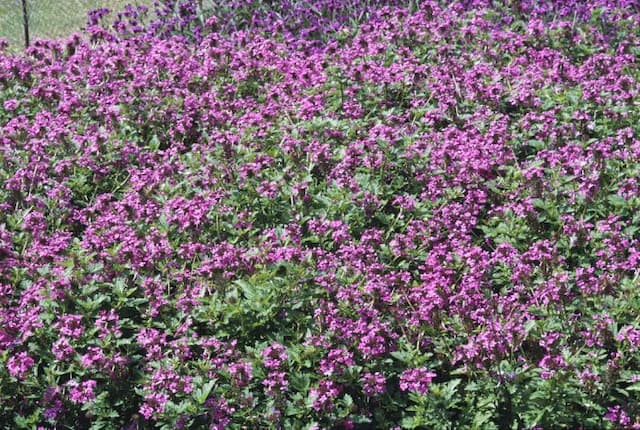
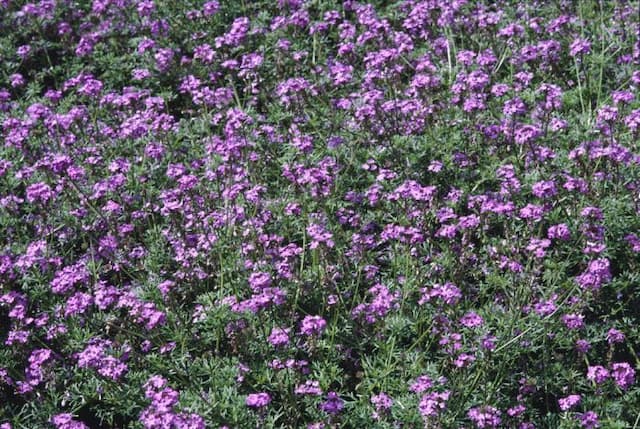
![Vervain [Endurascape Pink Bicolor]](/_next/image?url=https%3A%2F%2Fplants-admin.emdemapps.com%2Fimages%2Fplants%2F%2Fimages%2F604b594e749b0.png&w=640&q=75)
